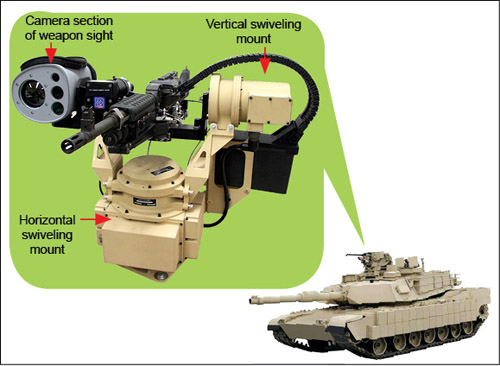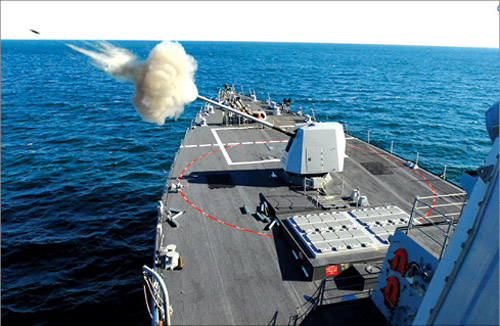Communication systems for SPG
When front-line troops encounter strong resistance from the enemy, they call for an artillery strike. A trooper, known as the forward observer (FO), is present among the front line troops. The FO generates that request through a radio to the fire direction centre (FDC), the overall command centre for SPGs throughout the battlefield. Six to eight guns are grouped to form what is known as a battery, which is commanded by a battery command centre (BCC). Firing commands from the FDC are issued to the appropriate BCC. The FO, FDC and the SPGs are all situated far away from each other.

In a typical mission, the FO generates the request for an artillery strike to the FDC. He intimates his precise location on the map and the target’s location with respect to his location. The FDC determines which battery would be able to engage the target most effectively and communicates the same to the BCC. It also determines which shell type has to be used, the required numbers, the elevation and orientation of the gun, etc. In the BCC, guns are directed accordingly to load, align and fire. As the firing is initiated, the FO actively reports to the FDC information, like impact of the shell, side to which the target shell landed and its distance. From these reports, the FDC deduces the coordinates and communicates the updates to the BCC. Trained FOs can direct the artillery fire even on specific targets, like stationary tanks. In an artillery barrage, they move the shell’s point of impact progressively. This is known as walking the fire to the target or a rolling barrage.
The process of receiving artillery-fire-support requests from various units operating at various sectors in the battlefield, categorising and prioritising them, allocating targets to the BCC, getting targets bombarded, collecting feedback through FOs, and giving correction orders, is called artillery C2. In the past, this was based on wireless radios and all calculations were done manually using slides and maps. these are carried out through rigorous training.
The FDC and BCC are slated to get closely integrated through computerised C2 systems. The FCS of the SPGs requires specific alignment to be entered, so it gets the SPG aligned easily. The FDC typically has a huge computer screen on which a detailed map of the battlefield is displayed. It is marked with positions of known enemy and friendly units, target sizes and locations, safety regions, available ammunitions at various batteries, etc. The FOs provided with imagers can send live videos by hooking their imagers to the radio. Through this, the FDC can see the result of the bombardment for themselves. Some of the functions the FDC can execute in a go are:
1. Taking account of the available munitions at the BCC
2. Identifying the required number of guns for a mission
3. Selecting the mode of bombardment and the required shell impact distribution, according to the type of target
4. Synchronising the firings
5. Simultaneously controlling several fire missions, where certain number of guns in a battery are used for bombarding targets of a different mission
The BCC for these SPGs are also mobile vehicles that follow these guns. All FCSs of the individual SPGs are connected with a radio data link to the BCC, which sends the target’s coordinates, required shell type and numbers through the radiolink to the FCS of the SPG. These parameters are displayed separately. The gunner enters these values into the FCS, which in turn aligns the gun. On receiving the fire command through the radio, these SPGs fire. This method of C2 is being tested and is expected to be deployed soon.
Some more systems
Automatic fire extinguishing system. A tank or an SPG contains live ammunition inside it. If it catches fire either due to enemy firing or by accident, the result can be catastrophic. The resulting explosion can destroy a turret weighing around 20 metric tonnes!

The automatic fire suppression system has sensors in the ammunition and engine compartments. These sensors detect fumes that rise before a fire and trigger a gas canister that contains halon (halogenated hydrocarbon) gas. This fire-retardant gas is released in milliseconds. The crew has to escape from the vehicle in a few seconds to save themselves. This system is effective only against accidental fires or meagre hits from enemy fire.
Close-range protection system. A tank or an SPG is a deadly monster, but only when the enemy is away from these machines—the striking range of these machines has a minimum distance below which they cannot engage the enemy. For shorter distances, machine guns are fitted in these systems. During a battle, these guns can be fired from under the protection of armour. But, to load these guns, operators have to come out of the armour.
To tackle this, remote-controlled weapon stations (RWSs) are being introduced. These are situated on the top of the turret and have a high-power machine gun. The way a target is engaged is similar to the target engagement through the main gun since inside these RWS there is a mini FCS similar to that of a tank’s. A joystick is used to control the movement of the machine gun. There is a camera and display for aiming and monitoring. With these RWSs, close-range infantry threats can also be dealt with, without exposing the shooter to the enemy.
Naval guns
In the past, guns were the primary armament of combat naval. These guns could even determine the size of the ships. These were used to fire at enemy vessels and on-shore installations, that too in both direct and indirect fire modes. Anti-ship cruise missiles that were introduced in the early sixties defanged these big guns and took their place. Due to this, today these guns have diminished in both size and power. The modern-day shipboard gun’s FCS uses a radar to derive the coordinates of the enemy vessel. These guns are autoloaded.
For direct firing modes, the FCS functions like a tank’s. But, for indirect firing support, it works like the FCS of an SPG. A naval gun’s FCS has to also take care of the wave factor because while firing there is a strong possibility of the wave heaving the ship upwards, and shifting the point where the shells will land. So, the FCS incorporates the gun stabilisation feature too for the indirect firing mode, unlike their land-based SPGs. These guns can shoot shells even faster than the tanks or SPGs.
The future
In the future, high-powered laser beam firing weapon platforms will replace big guns.
Until then, these big guns driven by electronic systems will rule the battlefield.
The author is working in BrahMos Aerospace and is pursuing a doctorate in military technology. He has contributed various articles in the past





